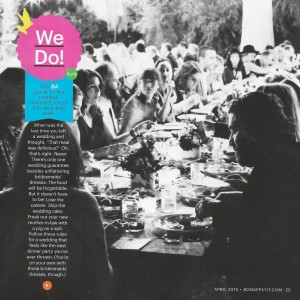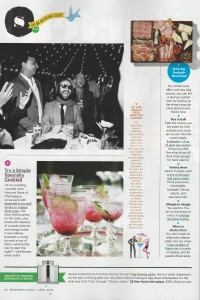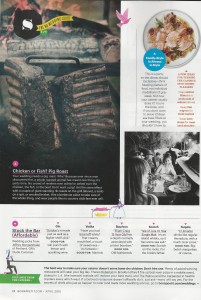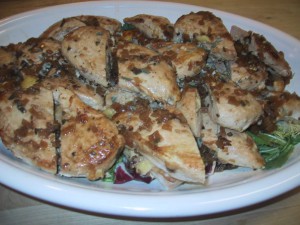It’s hard to know where to start when you open your longtime favorite food magazine and see your profession denigrated in the first page of editorial content! Bon Appetit’s April edition promises “We Do, A food lover’s guide to weddings” and starts off with the questionable moniker, “…the BA guide to the tastiest, booziest, most fun wedding ever…” Booziest? Seriously? But it does not stop there, as they go on to advise “Lose the caterer.”
Turning to the next page (yes, I’ll admit, the headline got me), they go into the details of how to (1) serve “assemble-it-yourself drinks on vintage trays”, (2) “DIY the Cocktail-Hour Food” and (3)“supplement (the bars) with passed cocktails” (by whom, if you lose the caterer?).
Turning the page, we find the directive to roast a whole pig; “…hire a BBQ place to take care of the whole thing….” (isn’t that catering, just asking?), and then “The best way to make sure your caterer doesn’t serve bone-dry chicken: Don’t hire one.” They recommend you contact your favorite trendy restaurant or celebrity chef to prepare the food at your wedding.
As we head into the last page, we encounter suggestions to “Go Ahead, Skip the Cake”, hire a food truck (we’ll get into that later in the discussion) and to “Put your least responsible friend in charge of (the) late night (bar). It’ll be more memorable than the parts of the night you planned to a T” accompanied with the idea that shots of Wild Turkey are the way to cap off the celebration. Oooh, aren’t we hip and cool now?
After I took a walk around the office to cool down, I tried to assess exactly which of these irresponsible and inflammatory sound bites I found the most offensive. I have been a chef and caterer as my full time profession for over fifteen years now, and go to a great deal of trouble to see that my clients get exciting, fun and great tasting food at their wedding celebrations. Yes, we have all had our experiences with rubber banquet chicken breasts (that’s another post entirely, here) and cold plates of surf and turf, but caterers today are putting out some amazing fresh and innovative food. Many of us have seen the inside and outside of the restaurant trade before choosing catering as our creative avenue. I have hired my share of talented restaurant chefs, only to be told what we, as caterers do, is “way too difficult and stressful.” Caterers are experts at bringing the restaurant to wherever the client chooses, be it an open field, a windy beach, a redwood forest or the middle of a vineyard. We serve hundreds of plates AT THE SAME TIME rather than in succession as is done in even the busiest restaurant kitchen. We oversee a myriad of details and timelines to ensure that the entire event flows smoothly and successfully.
It is ironic that the advertisement placed in the middle of this section is for Bon Appetit’s Vegas Uncork’d food and wine event, featuring three celebrity chefs. One of the best-kept secrets of these tasting events is who actually prepares the food…..yes, it is caterers! While client confidentiality prevents us from naming names, we are the ones who prepare the hundreds of tasting plates, peel the potatoes, mince the onion, set everything up in those little glass prep bowls and even prepare the “hero plate” that is shown and photographed. The celebrity chef or, in some cases magazine food editor slips on their pristine chef’s jacket and steps out in front of the cheering crowd. We are the ones who scour every grocery store for 100 miles to find the out-of-season stone fruit to duplicate the tart that the food editor created almost a year before for the companion article. We are the ones who take the celebrity chef’s intricate and multi-step restaurant recipes and prep every single component for their fifteen minutes of fame at the demo stage. If you have attended a luncheon or dinner at a charity event, supposedly prepared by a celebrity “guest” chef, it is almost certainly your local caterer who is back in the kitchen tent, pumping out the food while the guest of honor is schmoozing with the VIP guests.
Unless you are a Hollywood star or a Silicon Valley mogul, it is unlikely that your favorite trendy restaurant chef will be in the kitchen at your wedding celebration, even if that is who you are paying. Who do you think restaurant chefs hire to prepare the food at their own weddings? They hire caterers, who know how to manage the logistics and timing so that the hot food is served hot and the cold food is served cold.
Oh, and yes, all the DIY articles on the internet cannot prepare you for the shock of preparing and serving the large amounts of food required to feed 200 guests, much less keep it safe to consume without the benefit of a fully equipped restaurant kitchen on site. How many of your friends will want to bus, scrape and wash the mountains of dishes generated by groups of this size, much less sort and box the glassware? These are all things that your caterer does as a matter of course.
And let’s address the Food Truck myth. Do you want your 200 guests standing in line at the truck to order their food, being served by 1-2 people taking orders through a small window, and handing each order over to the 1-2 people working the line in the truck? When a caterer plates a meal for a wedding celebration, they usually have 4+ people plating on the line for each group of 50 guests, and this does not take into consideration the kitchen staff preparing or finishing the food and the service staff (one for every 15-20 guests) carrying the plates to the table. Yes, food trucks are fun and the food is tasty, trendy and not your usual banquet menu, but if you consider that it takes even three minutes for each order for two x 200 guests, that is 300 minutes , which would equal….almost 5 hours to feed everyone. Food trucks are great when not everyone wants to eat at the same time, which is why they work so well for festivals. Not the case at a wedding celebration, where dinner is often squeezed into an hour, maybe two in the context of the complete event.
We can’t forget what this article focuses on the most; the bar. The same “rule of lines” applies at the bar, which is why the article even goes on to recommend lots of bar staff. How many of your friends want to be bartenders when they are a guest at your wedding? Maybe, for about five minutes, or exactly as long as it takes to get themselves a drink. Professional caterers hire professional bar staff, trained and tested to ensure safe and sane alcohol service. If you take Bon Appetite’s advice to put your “least responsible friend” in charge of pouring drinks, who is going to be responsible when one of your guests drives off the road on the way back to the hotel from your rustic barn venue?
At the end of this rant, I guess what I’d like to get across is that catering is a profession. We are not just bored housewives that are throwing parties out of our home kitchens. As an aspiring caterer, I worked long hours as a server, prep cook and setup person at events. I pursued a culinary education not only in restaurant kitchens, but at the Culinary Institute of America. I worked for another caterer in all facets of the operation before considering opening my own company. I have a Bachelor’s degree in Business Administration and continue to educate myself in the areas of marketing, sales, customer service and accounting and finance. Our company is licensed, carries liability insurance, we pay taxes and subject ourselves to numerous necessary regulations for food and beverage safety. I continue to educate myself on food and event trends, attend industry conferences, belong to professional associations and network with others in our industry. Every catering company owner and chef that I know takes their work seriously, as it is a passion for many of us.
After almost 40 years as a loyal subscriber and reader of Bon Appetit, I will be cancelling my subscription. But more than that, I will continue to advocate for my chosen profession and all the hard working people who put in the tireless hours to make sure that our clients’ special day is just that, special. I guess I’m just not hip enough to appreciate the snarky editorial style of today’s Bon Appetit. I do plan to vote with my pocketbook, and hope you will do so as well. Had the magazine taken the time to do an in-depth review of wedding catering, and offer realistic alternatives to the reader, this sort of feedback might have been easier to swallow. However, this piece smacks of sensationalist journalism of the worst kind. Toss out a few gossipy bits, don’t support it with real research, and laugh your way to the bank. I count quite a few food writers and editors among my friends, and we are all equally dismayed at that state of food journalism today. Bon Appetit, I hope you wake up one day and look in the mirror, and see what a shadow of your former self you have become.







